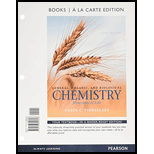
Concept explainers
a)
To Determine:
The gelatin can be added to the canned pineapple, but not to the fresh one.
Explanation of Solution
New pineapple contains Bromelain compounds, which is a proteolytic enzyme. The gelatin is a protein, which can be degraded by the proteolytic enzyme, hence, it cannot be used with the raw pineapple. In the case of the canned pineapple, the pineapple is preheated, which cause the deactivation of the bromelain. Hence, it can be added to the canned pineapple.
b)
To Determine:
The fresh pineapple juice can be used to tenderize milk.
Explanation of Solution
The tenderizing of meat is done by the breaking down of the collagen. This can be achieved by the treatment of the meat with the proteolytic enzyme present in the pineapple.
a) In the raw pineapple, the proteolytic enzyme is present, which can react with the gelatin. The canned pineapple has deactivated bromelain, which cannot react with the gelatin.
b) The proteolytic enzyme of the fresh pineapple tenderizes the meat.
Want to see more full solutions like this?
Chapter 20 Solutions
General, Organic, and Biological Chemistry: Structures of Life, Books a la Carte Edition; Modified MasteringChemistry with Pearson eText -- ValuePack ... Chemistry: Structures of Life (5th Edition)
 ChemistryChemistryISBN:9781305957404Author:Steven S. Zumdahl, Susan A. Zumdahl, Donald J. DeCostePublisher:Cengage Learning
ChemistryChemistryISBN:9781305957404Author:Steven S. Zumdahl, Susan A. Zumdahl, Donald J. DeCostePublisher:Cengage Learning ChemistryChemistryISBN:9781259911156Author:Raymond Chang Dr., Jason Overby ProfessorPublisher:McGraw-Hill Education
ChemistryChemistryISBN:9781259911156Author:Raymond Chang Dr., Jason Overby ProfessorPublisher:McGraw-Hill Education Principles of Instrumental AnalysisChemistryISBN:9781305577213Author:Douglas A. Skoog, F. James Holler, Stanley R. CrouchPublisher:Cengage Learning
Principles of Instrumental AnalysisChemistryISBN:9781305577213Author:Douglas A. Skoog, F. James Holler, Stanley R. CrouchPublisher:Cengage Learning Organic ChemistryChemistryISBN:9780078021558Author:Janice Gorzynski Smith Dr.Publisher:McGraw-Hill Education
Organic ChemistryChemistryISBN:9780078021558Author:Janice Gorzynski Smith Dr.Publisher:McGraw-Hill Education Chemistry: Principles and ReactionsChemistryISBN:9781305079373Author:William L. Masterton, Cecile N. HurleyPublisher:Cengage Learning
Chemistry: Principles and ReactionsChemistryISBN:9781305079373Author:William L. Masterton, Cecile N. HurleyPublisher:Cengage Learning Elementary Principles of Chemical Processes, Bind...ChemistryISBN:9781118431221Author:Richard M. Felder, Ronald W. Rousseau, Lisa G. BullardPublisher:WILEY
Elementary Principles of Chemical Processes, Bind...ChemistryISBN:9781118431221Author:Richard M. Felder, Ronald W. Rousseau, Lisa G. BullardPublisher:WILEY





